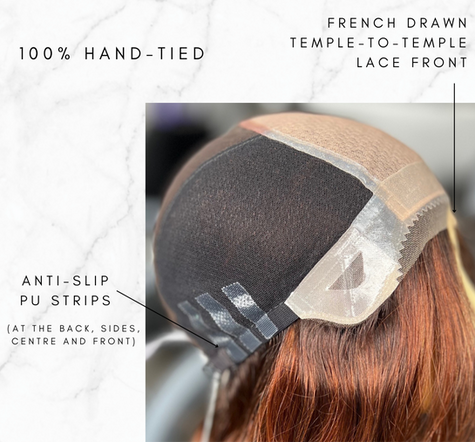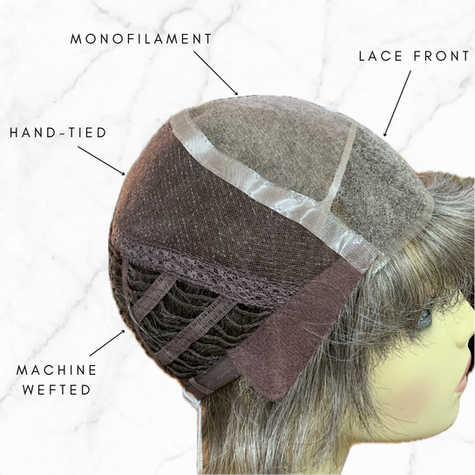Cap Types - Which one is right for me?
When faced with choosing the right wig for you, especially if you’re new to the matter, it can be very challenging purely based on all the different choices you have available. That’s why we’re here to help! We will narrow down all the differences between the different cap types in order to make choosing your wig that little bit easier. Something to bare in mind is that a lot of wigs combine more than one cap type, for example it may be a mono top with a lace front. Rest assured, there really is something for everyone.
Machine Wefted
The classic wig cap and the most inexpensive. This cap style is comprised of strips of seams that the hairs are attached to, which hold the cap together. This style cap is ideal for women who like that bit of extra volume in their wigs, as the hairs on other wig caps .eg. Mono, lie flatter. Whereas on this style base, an action called permatease is used which, albeit, doesn’t look as natural as other cap types, it does provide the desired volume. This base type is also perfect for those occasional wig wearers due to their affordability and wide range of styles. Something else to remember with this base type is that isn’t as breathable as the mono top wigs, for example.
In the picture below, you can see the permatease. It gives the appearance that it has been teased with a comb to add a backcombed effect. This adds the lift and volume to the wig which is unachievable in other base types. This also ensures that the style remains the same so you won’t lose that volume or have to keep teasing it – making it a very easy wig to care for.


Monofilament
There are many variations of a monofilament base wig, which we admit can be pretty confusing. They all consist of the same thing, the base pictured (right) – just the size and placement tends to change.
Types of Mono Wigs:
Monofilament Top
Monofilament Crown
Part Monofilament
Double Monofilament
Monofilament Top
The wigs pictured below are examples of a monofilament top. This allows for the wearer to adjust the parting of their wig to anywhere within that area, even a fringe could be cut into it. This style of base maintains the natural look that mono wigs offer. It creates the illusion of the hair growing out of the scalp. Monofilament wigs are more expensive compared to wefted ones and so are less suitable for those on a low budget, but these cap types are virtually undetectable as a wig and we feel are 100% worth that bit of extra money. Monofilament wigs are more comfortable and softer against the scalp than wefted wigs, plus they’re more breathable than the standard wefted base.


Monofilament Crown
As pictured below, with a mono crown wig, the positioning of the monofilament construction just moves to the crown area of the head. In this case, this area will appear realistic and maintain the mono wig image of hair growing from the scalp and offering a multi-directional parting. Wigs with this base type generally tend to have the mono crown and the rest of the base be machine wefted.

Part Monofilament
In essence, this means that the area in which the parting falls is constructed with monofilament to provide a natural looking parting, meanwhile the rest of the wig is usually machine wefted. The wig pictured below also offers a lace front.

Double Monofilament
A double layer monofilament top (below) ensures a smooth finish therefore maximum comfort. The look of hair growth from your scalp is still provided with this wig base, as is the ability to wear this style with the parting wherever you choose. This type of cap is highly recommended for clients with sensitive skin as that extra layer of monofilament prevents scalp irritation. This cap comes as standard with the Amore range of wigs, stocked in the salon.

Lace Front
A lace fronted wig creates the illusion of a natural hairline and allows for styling of the wig away from the face. This style is perfect for those wanting to wear their wig up or styled. These lace fronts (see below) sometimes come pre-trimmed or they may require the lace to be cut by yourself.
Again, once you start adding lace fronts to a wig requirement, the price does increase along with it, making lace fronted wigs that bit more expensive. You won’t be disappointed with a lace front wig – they’re a celebrities favourite (think Kylie Jenner) and offer endless styling options.


Hand-Tied
Hand tied wigs are probably the most expensive base type, but for good reason. If a wig says it is 100% hand tied, every single hair in that wig has been meticulously hand tied onto a soft mesh cap. No wefts or mechanical stitching will be used and this technique gives the appearance of natural hair growth all over. This is the most lightweight cap out of all of them and is so soft and delicate, we’ve had clients before say that they’ve forgotten they’re even wearing a wig. 100% hand-tied wigs can be combed or styled in any direction so they are very versatile.
Something to look out for, some wigs may just have a hand tied back and and still be wefted at the bottom or a monofilament top, for example. So unless it says 100% hand-tied then there will be other construction types on the base.

These are two examples of wigs with different cap features combined:




Yorumlar